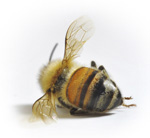25
Apr
Multiple Accounts of Honey Bee Death and Damage Continue
(Beyond Pesticides, April 24, 2014) Reports of honey bee deaths have been emerging around the nation: from bee deaths in California’s almond groves and ”˜mysterious’ road-side bee deaths in Oregon, to astronomical overwintering losses in Ohio. The reports are intensifying the ecological crises of Colony Collapse Disorder (CCD) ””a phenomenon  typified by the mass abandonment of hives and bee die-off. CCD poses significant issues for many agricultural crops, such as almonds, apples, cherries and blueberries, that are almost completely reliant on honey bees for their pollination services.
typified by the mass abandonment of hives and bee die-off. CCD poses significant issues for many agricultural crops, such as almonds, apples, cherries and blueberries, that are almost completely reliant on honey bees for their pollination services.
In California, a total of 80,000 dead or damaged bee hives were reported after pollinating almond trees in the San Joaquin Valley, a region that is known for its agricultural productivity. Beekeepers have pointed to pesticides as the primary culprit. Almond pollination in California requires an army of 1,300 commercial beekeepers from around the nation. However, this year beekeepers have seen higher damages to hives than usual.
Damage to the honey bee hives this spring has been so pronounced that the U.S. Environmental Protection Agency (EPA) convened an impromptu meeting with beekeepers in Los Banos, California. The meeting brought together 75 beekeepers who testified that 75 percent of their hives showed severe damage following almond pollination. Beekeepers pointed to ”˜tank mixing’ of several insecticides, which are toxic by themselves and even more so in combination. Almond farmers often use clothianidin, imidacloprid and thiamethoxam ””chemicals that have been banned in the European Union (EU) due to an unreasonably high-risk to honey bees”” as well as tolfenpyrad and cyantraniliprole, products that just recently came on the market after EPA registration.
Beekeeper Gene Brandi of Los Banos told The Sacramento Bee that pesticides used do not have explicit label warnings about their possible effects on bees. Although EPA assessed their toxicity for adult bees, and found them to be nontoxic, “Nonetheless, these chemicals affect the bee colony by affecting the brood,” Mr. Brandi said. “The damaged hives are a significant number, and enough to cause alarm.”
In Oregon, officials are now investigating the death of thousands of honeybees along a highway running southwest of Portland. Bruce Pokarney of the Oregon Department of Agriculture estimated that the swarm of bees could have ranged in number from one to 10,000. Officials told Reuters that they are currently working under the assumption that the bees swarmed while attempting to cross the road and ended up as roadkill, however samples have been sent to Oregon State University to check for possible disease or so-called “other issues,” such as pesticides. The die-off marks the second in Oregon this year, after 50,000 bumblebees were found dead in a parking lot in Wilsonville after feeding on a linden tree doused with the bee-killing pesticide dinotefuran.
Across the U.S., Ohioan beekeepers have just reported overwintering losses between 50 and 80 percent, according the The Columbus Dispatch, which come on top of 30 to 60 percent die-offs the previous year. “It’s a pretty devastating loss,” said Ohio beekeeper Barry Conrad, who maintains 76 hives. “It’s been getting worse each year.” The winter was an unusually harsh one, however, beekeepers including Mr. Conrad have pointed to pesticides as the key issue.
Every year the Bee Informed Partnership, in collaboration with the Apiary Inspectors of America and the U.S. Department of Agriculture, provides a national survey of honey bee winter losses (see 2012-2013 losses). When the survey is released in May, we should see whether these reported events are demonstrating nationwide trends.
BEE Protective
On Earth Day 2013, Beyond Pesticides and Center for Food Safety joined forces to launch the BEE Protective Campaign, with the goal of protecting honey bees and other pollinators from pesticides.The BEE Protective Campaign gives you the tools to help honey bees and other pollinators right in your own community. Here are some ways to take action:
- Plant bee friendly habitat in your own backyard
- Join us in asking Lowe’s and Home Depot and other leading garden centers to take action and stop the sale of neonicotinoids and plants treated with these chemicals.
- Tell your member of Congress to support the Save America’s Pollinators Act.
- Learn more about the science behind bee declines in No Longer a BIG Mystery
- Sign the Pesticide Free Zone Declaration and pledge to maintain your yard, park, garden or other green space as organically-managed and pollinator friendly.
- Use our model resolution to transform your community and raise awareness about pollinator health.
All unattributed positions and opinions in this piece are those of Beyond Pesticides
Sources: The Sacramento Bee, Reuters, The Columbus Dispatch











have you seen any reports of the chemicals contaminating the honey?
April 25th, 2014 at 11:32 am